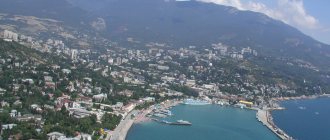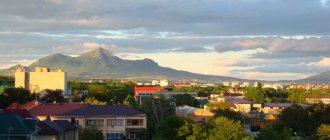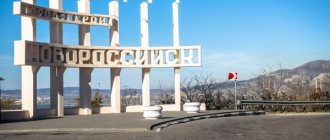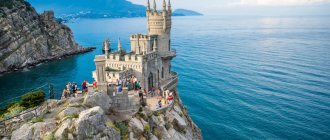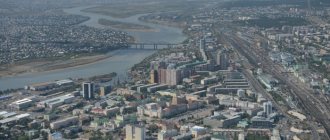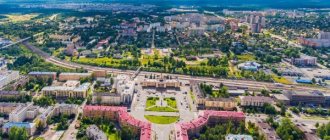Yalta is a popular destination visited by Russian tourists. And since the time the city began to be located in Russia, the flow of tourists has increased significantly. The explanation is simple: the climate in Yalta is pleasant Mediterranean, and the city itself has a rich history and many attractions that have been preserved for many years.
Geography and climate
Yalta is located on the shore of the Black Sea bay of the same name in the south of the Crimean Peninsula. The city is located in the valleys of two small rivers Derekoyka and Uchan-Su on the hills surrounded by the Crimean mountains. In the north-west stretches the Yalta yayla with the peak of Kemal-Egerek (1530 m), and in the south there is the picturesque Ai-Petri (1234 m).
Yalta has a warm Mediterranean climate and is located at the same latitude as Italian Genoa. The resort climate is characterized by hot summers, mild winters, and long and warm autumns. At the height of summer, the water temperature in Yalta warms up to 26 - 28 °C. The resort is also famous for its many natural parks and green areas with introduced plant species, among which the Vorontsovsky and Livadia parks stand out.
Yalta
Crime
The criminal situation in Yalta has generally stabilized. Since the entire leadership and majority of the internal composition of law enforcement agencies changed in 2010, the percentage of crimes solved has begun to increase. If we talk about specific statistical figures, then in 2013 serious and especially serious offenses decreased by 5.5%.
In recent years, scammers have become more active in Yalta. They mainly trade through SMS messages or go to the apartments of old people, posing as employees of social services and banks. Also, the percentage of crimes committed by teenagers and young people has recently increased.
It is worth noting that Yalta leads in the number of “land” crimes. This is understandable, because this is a resort. In the last 6 months alone, more than 200 illegal decisions of government authorities on the disposal of land plots have been canceled. And this is only what was verified during the prosecutor's audit. The real numbers are unlikely to ever emerge.
Among the most “loud” and resonant crimes committed in Yalta, several can be highlighted. This murder of a newborn on the Ai Petri plateau shocked all the residents of Yalta... And after 5 months, the residents of the city were stunned by law enforcement agencies, who proved that the child was killed by his own mother. And also dozens of murders committed by a criminal group of “black realtors” who operated in Yalta, forced apartments to be transferred to themselves, and then brutally killed their victims. Last year, all members of the gang were detained, the coordinator was sentenced to capital punishment in the form of life imprisonment
Beaches of Yalta
- Primorsky beach is the central beach of Yalta, small pebbles. It is short in length (about 500 meters). Equipped with all necessary infrastructure.
- Massandra Beach is another famous beach in the center of Yalta, approximately 500 m long. It is divided into several zones and has a “Blue Flag” (a blue flag is an international award indicating that a beach meets high standards).
- The beach near the Intourist hotel is a good pebble beach with a Blue Flag. Paid for vacationers who are not guests of the hotel of the same name.
- Golden Beach, located 8 km from Yalta near the Kurpaty sanatorium.
- Nikitsky Beach is a small secluded beach 7 km from the city center.
- Dolphin Beach is a free beach in the village of Livadia, 3 km from the center of Yalta.
Migration
Since 2004, statistics have reported a positive balance of migration. Since 2014, residents of the peninsula have been actively leaving their homes, leaving temporarily or for permanent residence in other regions of the Russian Federation, mainly in capital cities, the Moscow region and the Krasnodar Territory; the outflow of the population is associated with the search for work, a more favorable climate and a place for children to study . Part of the rural population moved to Sevastopol.
Story
The environs of Yalta were inhabited in ancient times by the Tauri, the indigenous people of Crimea. It is believed that the first settlement here was founded by the Greeks in Antiquity. The modern name of the city most likely comes from the Greek "Yalita", which means "coastal".
The founding date of Yalta is considered to be 1154, when in the Middle Ages a settlement was founded here by merchants from Venice, who were then replaced by the Genoese. In the second half of the 15th century, Yalta was captured by the Turks and included in the Ottoman Empire. Then the settlement was part of the Crimean Khanate.
Yachts. Yalta
In 1783, Crimea was annexed to the Russian Empire. Yalta was a small fishing village. Everything changed under Governor-General Vorontsov, who distributed land here, on which the nobles began to build luxurious estates. In 1838, Yalta received city status. After the Crimean War, Yalta became one of the most popular resorts in the Russian Empire.
At the end of the 19th century, an embankment, water supply and sewerage were built here. After the Civil War, most of the Yalta palaces were in disrepair. From 1941 to 1944, Yalta was under German occupation. In February 1945, the Yalta Allied Conference was held at the Livadia Palace. After the end of the war, Yalta began to be considered the main resort of Crimea, maintaining this status to this day.
Information about the Republic
As a subject of the Russian Federation, the Republic of Crimea belongs to the Southern Federal District and the North Caucasus economic region. The date of formation is considered to be March 18, 2014. It was on this day that the Crimean Peninsula was officially annexed to Russia, leaving the control of Ukraine, of which it was once a part. The international community denies the annexation of Crimea to Russia, considering this territory as part of Ukraine.
Local residents are mainly involved in various industries, construction, healthcare and trade. Tourism and agriculture are well developed. The mild climate makes the Black Sea coast attractive to tourists from all over Russia. Sea and river ports make it possible to deliver products produced here to anywhere in the world.
Attractions
Swallow's Nest
Swallow's Nest is one of the symbols of Crimea, a decorative neo-Gothic castle rising on a picturesque cliff above the sea. This building was built in 1912. During Soviet times, the reading room of a nearby sanatorium was located here for some time. Then the structure was practically abandoned due to its disrepair. Now this bright attraction is again available for visiting.
Livadia Palace
Livadia Palace is one of the most famous attractions of Yalta and the summer residence of Russian emperors. The palace was built at the end of the 19th century by order of Emperor Alexander III. This is a beautiful building in the Italian Renaissance style with a park in which ancient gazebos, fountains and sculptures have been preserved.
Massandra Palace
Massandra Palace is a beautiful building in the French style with an English park. The palace was built in the 19th century by Count Vorontsov in the style of a knight's castle. Then the building was taken over by Emperor Alexander III, by whose order the palace was rebuilt in the style of the era of Louis XII.
Embankment
The embankment is one of the most favorite places for walks for residents and guests of the city. The promenade is 1.7 km long and begins at the Primorsky Park, which is actually its continuation. The Yalta embankment begins its history at the end of the 19th century and has recently undergone a large-scale reconstruction. The promenade has two levels: the lower one, which runs by the sea, and the upper one with shops, restaurants and historical buildings.
Interesting sights of the Yalta embankment:
- Hotel Oreanda is an elegant building from the early 20th century.
- The Roffe Baths are a historic building built at the end of the 19th century in the Moorish style. Nearby there is a bronze sculpture “Ladies with a Dog” and a fountain.
- The ship "Argo" is a stylization of an ancient Greek ship.
- Hotel "Tavrida" is one of the oldest in Crimea
Cathedral of St. Alexander Nevsky
Cathedral of St. Alexander Nevsky is the main church of Yalta, which was built from 1891 to 1902. This is a beautiful building in traditional Russian style with a belfry.
Armenian Church
The Armenian Church is a striking example of early 20th century Armenian architecture with expressive frescoes under the dome.
Church of John Chrysostom
The Church of St. John Chrysostom is the oldest church in Yalta, built in the first half of the 19th century. The original historical building was destroyed in 1942 and restored in the 90s of the 20th century.
Roman Catholic Church
The Roman Catholic Church was built in the early 20th century in the Gothic Revival style.
Palace of the Emir of Bukhara
The Palace of the Emir of Bukhara is a beautiful building in the Moorish style, built in 1911.
Vorontsov Palace
Vorontsov Palace is a unique palace complex of the mid-19th century in the Moorish style, built by order of Count Vorontsov. It is famous for the fact that the interiors and furniture of that period have been preserved here.
Golitsyn Palace
Golitsyn Palace (Gaspra) is an architectural ensemble of the 19th century in the medieval Gothic style.
Dulber
Dulber is a 19th century palace complex built for a member of the Romanov dynasty. Considered a masterpiece of neo-Moorish architecture. The building has beautiful arched windows with oriental-style ornaments and walls decorated with multi-colored mosaics.
Yusupov Palace
The Yusupov Palace was built at the turn of the 19th and 20th centuries and is an excellent example of Italian neo-Renaissance architecture.
Other interesting places in Yalta:
- Chekhov's house-museum, where the great writer spent the last years of his life.
- Cable car opened in 1967.
- Oceanarium - the largest in Crimea
- Nikitsky Botanical Garden, founded in 1811.
Ai-Petri
Ai-Petri is one of the most picturesque peaks of the Crimean mountains with a height of 1234 meters. The name of the mountain is of Greek origin and is translated as “Saint Peter”. Ai-Petri is famous for its fogs and beautiful views. This mountain is located near the city of Alupka.
Population
In terms of population, Yalta ranks honorably third among all cities on the peninsula. About 90 thousand people permanently live in Yalta itself. Moreover, every holiday season this figure increases by 300,000 - 500,000 people due to city guests and tourists.
As for the gender and age group of the population, 45% are men, and 55% are representatives of the fair sex. It is noteworthy that in recent years the percentage of the population that is younger and older than working age has increased sharply. But the percentage of the working-age population is constantly decreasing.
If we talk about the demographic situation as a whole, it has almost the lowest indicators in Crimea. The average birth rate is 9.3 per 1000 people. The mortality rate exceeds these indicators by 2 times.
Residents of Yalta on May Day
Recently, the percentage of marriages has increased and divorce cases have decreased. It is interesting that Yalta residents get divorced least of all in the cities of Crimea.
If we talk about the education of city residents, there is no clear answer. There are not many higher educational institutions in the city, in particular only three: the Crimean Humanitarian University, the Institute of Economics and Management, and the European University. Mostly a variety of colleges and schools predominate. In general, education and its accessibility are at an average level.
The people here are friendly, friendly, accustomed to numerous tourists. They will tell you how to get there and how to get there. True, the traders at the markets are a little rude.
Where is the best place to move with children?
Old Yalta is definitely not recommended for families with small children or a desire to have them in the near future. It is difficult to fall asleep there, and there are not enough kindergartens and schools. The most suitable areas for living in this case are considered to be New Yalta, Chekhovo and Nikita.
The first option is suitable for people with average incomes - apartments in the area are relatively inexpensive, there are enough schools, kindergartens and playgrounds, and it will not be difficult for parents to get to work in any area.
Chekhovo is for the wealthier, and Nikita is for the wealthy. But in these places the environmental situation is better, and children will be able to play in their own safe courtyards. Massandra may also be a good option. There are schools and kindergartens in the area, the atmosphere is calm.
Old Town (Drazhinka) • on the map
The next most popular area of Yalta is the area of the old city (it is also called the “Massandra settlement”): Drazhinsky, Massandrovskaya, Tolstoy, Nizhne-, Sredne- and Verkhneslobodskie streets, the beginning of Sverdlova street, Matrossky lane and Polikurovskaya
This part of Yalta is characterized by dense, chaotic buildings and a continuous private sector. The old town is popular mostly in the high season, since within walking distance there is one of the best beaches in all of Big Yalta - Massandra, and within a 15-20 minute walk there is the Massandra park and the beach of the Yalta-Intourist hotel with a sea pier, an aquarium and night clubs.
Pros of the old city : walking distance to the sea and excellent beaches, close to the center and the embankment, there are a couple of canteens, a lot of cafes and restaurants, grocery and wine stores, shops with fresh fruit, and 20 minutes away the night club “Seagull on the Beach”.
Disadvantages of the old city : there is no public transport, all streets except Drazhinsky and Sverdlov are located on a hill with a decent slope, housing prices are above average, there is heavy traffic on Drazhinsky Street during the season.
It doesn’t hurt: renting a car in Crimea
Public transport : there is no public transport in the old city at all (the nearest stop “Veshchevoy Rynok” is a 10-15 minute walk), but during the season there are golf carts running along Drazhinka, which for 100-150 rubles take you to the beaches and to the Yalta-Intourist hotel "
Who is this area suitable for : beach lovers, party-goers and large groups who prefer to spend evenings with loved ones.
The best accommodation options in the old town of Yalta : the Yalta-Intourist complex, the Akter park hotel, the Coral mini-hotel, the Allegro park hotel, the Villa Tatyana hotel, the Loker club hotel right on the beach .
Apartments and private sector in the old town of Yalta
Primorsky Park area • on the map
Surrounded by the sanatoriums “Russia”, “Yalta” of the KChF and “Eagle’s Nest”, Primorsky Park adjoins the embankment on the side opposite the old city, including the Lenin embankment, expanded in 2022, Kommunarov Street and Gagarinsky Spusk
Now this once green area is a concentration of modern high-rise buildings with a large number of hotels, apartments, restaurants and spa complexes in close proximity to the sea. This is a well-developed area in terms of infrastructure with an excellent location and limited traffic, so in the high season, even with high prices, accommodation options here sell out very quickly.
Advantages of the Primorsky Park area : convenient location, modern architecture, virtually no elevation changes, most of the options are accessible for people with limited mobility, the embankment and equipped beaches “Primorsky”, “Korsar”, “Krasotel” are a 2-3 minute walk away, the vast majority of options will be on first line.
Disadvantages of the Primorsky Park area : high housing prices.
Public transport : in the upper part of the park there is a stop “Colonnade”, through which minibuses No. 11 and 35 pass from the bus station through the entire center of Yalta.
Who is this area suitable for : connoisseurs of comfort, party-goers, people with limited mobility, lovers of beach holidays, evening walks and cultural life.
The best accommodation options in Primorsky Park : SPA hotel "Primorsky Park", eco-hotel "Levant", apartments "Opera Prima", apartments "Lotus", hotel "Sun City".
Apartments and private sector in the Primorsky Park area of Yalta
Where is the private sector located?
The private sector of Yalta is concentrated in the areas:
- Chekhovo (includes the Avangard microdistrict)
- Vasilyevka
- Drazhinsky
- Embankment.
In Chekhovo (Avangard) private old houses have been preserved. Modern cottages and luxurious painted villas with jacuzzi are often built next to them.
In Vasilyevka, all the houses are old, so they are cheaper.
On Drazhinsky, cottages and large private houses predominate. The Naberezhnaya microdistrict consists of 70% private buildings. Huge mansions with many bedrooms have been built here.
- A selection of inexpensive cottages with good reviews
Forecast
In general, the Republic is not threatened by a migration collapse; the population remains at a consistently high level, which allows indigenous residents to feel quite comfortable at home, and tourists to enjoy a good holiday on the Black Sea coast.
The Crimean Peninsula, including Sevastopol, is part of the territory of the Russian Federation, annexed in 2014 as a result of a referendum. The population is mainly Russian. Crimean Tatars and Ukrainians, representatives of other nationalities also live here. They speak Russian, Crimean Tatar and Ukrainian. They profess Orthodoxy and Islam.
